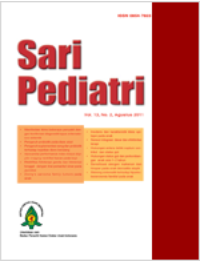Faktor Risiko Kematian Neonatus dengan Penyakit Membran Hialin
Sari
Latar belakang.Angka kematian bayi (AKB) menurut Survei Demografi dan Kesehatan Indonesia (SDKI)
pada tahun 2002-2003 adalah 35 per 1000 kelahiran hidup. Dua pertiga kematian bayi merupakan kematian
neonatal dan disebabkan terutama oleh persalinan prematur. Penyakit membran hialin (PMH) merupakan
penyebab terbanyak dari angka kesakitan dan kematian pada bayi prematur.
Tujuan.Mengetahui faktor-faktor risiko yang memengaruhi kematian pasien PMH yang dirawat di Instalasi
Maternal Perinatal RSUP Dr. Sardjito.
Metode. Rancangan penelitian yang digunakan adalah kasus-kontrol berdasarkan data sekunder dari data
dasar neonatus dan catatan medik pasien bayi baru lahir yang dirawat dan didiagnosis PMH di RSUP
Dr.Sardjito, Yogyakarta selama tahun 2007 – 2011.
Hasil. Proporsi kematian neonatus dengan penyakit membran hialin di RSUP Dr. Sardjito selama 2007
– Oktober 2011 adalah 52%. Faktor risiko kematian neonatus dengan penyakit membran hialin yang
bermakna secara statistik adalah asfiksia dengan OR 4,97 (IK 95% 2,39-10,28). Analisis dengan metode
regresi logistik menunjukkan bahwa asfiksia merupakan faktor risiko independen kematian neonatus dengan
penyakit membran hialin (aOR 5,15, IK 95% 2,43-10,91).
Kesimpulan.Asfiksia merupakan faktor risiko independen kematian neonatus dengan penyakit membran
hialin. Penanganan asfiksia dengan resusitasi yang tepat diperlukan untuk menurunkan risiko kematian
neonatus dengan penyakit membran hialin. S
Kata Kunci
Teks Lengkap:
PDFReferensi
Bappenas. Laporan perkembangan pencapaian millennium development goals Indonesia 2007. Jakarta:
Kementerian Negara Perencanaan Pembangunan
Nasional/Badan Perencanaan Pembangunan Nasional,
Papageorgiou A, Pelausa E, Kovacs L. The extremely
low-birth-weight infant. Dalam: MacDonald, MMK
Seshia, MD Mullet, penyunting. Avery’s neonatology
pathophysiology and management of the newborn. Edisi
Philadelphia: Lippincott Williams & Wilkins;2005.
h.459-89.
American Lung Association (ALA) (2006). Lung disease
data at glance: respiratory distress syndrome (RDS).
Diunduh dari: http://www.lungusa.org.
American Lung Association (ALA) (2008). Lung disease
data at glance: Respiratory distress syndrome (RDS).
Diunduh dari: http://www.lungusa.org.
Gomella TL, Cunningham MD, Eyal FG, Tuttle D.
Neonatology: management, procedures, on-call problems,
diseases and drugs. New York: McGraw Hill company;
Lemons JA. Very low birth weight outcomes of the National Institute of Child Health and Human
Development Neonatal Research Network, January 1995
through December 1996. Pediatrics 2001;107:e1.
Wardhani DM, Wandita S, Haksari EL. Risk factors of
neonatal mortality of referred babies with birthweight
of 1000 - <2500 grams. Berkala Ilmu Kedokteran
;41:143-51.
Kamath BD, MacGuire ER, McClure EM, Goldenberg
RL, Jobe AH. Neonatal mortality from respiratory
distress syndrome: Lessons for low-resource countries.
Pediatrics 2011;127:1139.
Fidanovski D, Milev V, Sajkovski A, Hristovski A, Kojiv L,
Kimovska M [Mortality risk factors in premature infants
with respiratory distress syndrome treated by mechanical
ventilation]. Srp Arh Celok Lek 2005; 133:29-35.
Nichpanit, S Risk factors for death among newborns with
respiratory distress syndrome at Kalasin Hospital. Srinagarind
Med J 2005;20: 255-61.
Bhutta ZA, Yusuf K. Profile and outcome of the respiratory
distress syndrome among newborns in Karachi: Risk factors
for mortality. J Trop Pediatr 1997;43:143-8.
Molina, JJP, Jacobo OB, Valdivia JMR Enfermedad de
membrana hialina: mortalidad y factores de riesgo maternos
y neonatales. Ginecol Obstet Mex 2006;74:354-9.
Kumar A, Bhat BV Respiratory distress in newborn. Indian J
Matern Child Health 1996;7:8-10.
Malloy, MH Impact of Cesarean section on neonatal mortality
rates among very preterm infants in United States, 2000-2003.
Pediatrics 2008;122:285-92
Lee, HC, Gould JB. Survival advantage associated with
cesarean delivery in very low birth weight vertex neonates.
Obstet Gynecol 2006;107:97-105.
Deng R, Tang BZ, Liu H, Qu Y, My DZ Risk factors on
the occurrence and prognosis of neonatal hyaline membrane
disease. Sichuan Da Xue Xue Bao Yi Xue Ban 2010;41:688-91
(abstrak).
Kenny JD, Adams JM, Corbet AJS, Rudolph AJ The role
of acidosis at birth in the development of hyaline membrane
disease. Pediatrics 1976;58:184.
Omer, MIA, Robson E, Neligan GA. Can initial resuscitation
of preterm babies reduce the death rate from hyealine
membrane disease?. Arch Dis Child 1974;49:219-21.
Robson E, Edmund H. Resuscitation of preterm babies at birth
reduces the risk of death from hyaline membrane disease. Arch
Dis Child 1982;57:184-6.
Zaw, W, Gagnon R, da Silva O. The risks of adverse neonatal
outcome among preterm small for gestational age infants
according to neonatal versus fetal growth standards. Pediatrics
;111:1273.
Bry K, Lappalainen U, Hallman M. Intraamniotic interleukin-1
accelerates surfactant protein synthesis in fetal rabbits and
improves lung stability after premature birth. J Clin Invest
;99:2992-9.
Jobe, AH. Antenatal associations with lung maturation and
infection. J Perinatol 2005;25:S31-5.
Purba, MA. Faktor prediktor mortalitas sepsis neonatorum
awitan dini di RSUP Dr. Sardjito Yogyakarta (Tesis).
Yogyakarta: Fakultas Kedokteran Universitas Gadjah Mada,
Jones RWA, Pickering D. Persistent ductus arteriosus
complicating the respiratory distress syndrome. Arch Dis Child 1977;52:274-81
Clarke DR, Paton BC, Way GL, Stewart JR. Patent ductus
arteriosus ligation and respiratory distress syndrome in
premature infants. Ann Thorac Surg 1976;22:138-45.
Rojas MA, Lozano JM, Rojas MX, Laughon M, Bose CL,
Rondon MA, Charry L, dkk. Very early surfactant without
mandatory ventilation in premature infants treated with early
continuous positive airway pressure: A randomized, controlled
trial. Pediatrics 2009;123:137.
Ho, NK. Factors affecting responses of infants with
respiratory distress syndrome to exogenous surfactant
therapy. Singapore Med J 1993;34: 74-7.
DOI: http://dx.doi.org/10.14238/sp15.2.2013.75-80
Refbacks
- Saat ini tidak ada refbacks.
##submission.copyrightStatement##
##submission.license.cc.by-nc-sa4.footer##
Email: editorial [at] saripediatri.org


Sari Pediatri diterbitkan oleh Badan Penerbit Ikatan Dokter Anak Indonesia
Ciptaan disebarluaskan di bawah Lisensi Creative Commons Atribusi-NonKomersial-BerbagiSerupa 4.0 Internasional.




